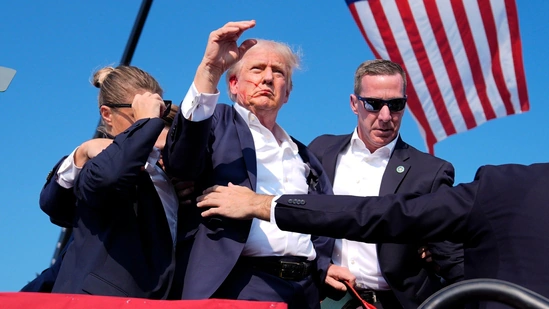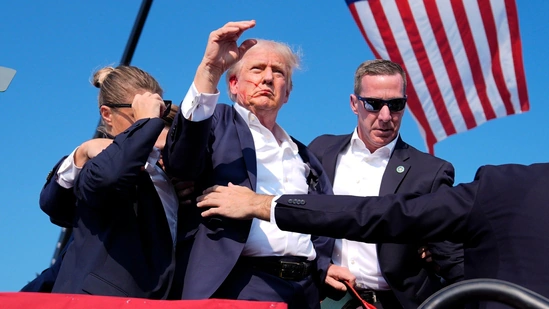Former US President Donald Trump was the target of an alleged assassination attempt during an election rally in Pennsylvania on Saturday. Trump was swiftly pulled from the stage by Secret Service agents, with his ear covered in blood, after shots were fired. The Secret Service formed a barricade around him and confirmed that Trump is “fine” following the incident. The shooter, identified as Thomas Matthew Crooks, 20, was killed by Secret Service snipers after firing from a rooftop. The FBI has yet to determine a motive for the attack. This marks the first attempt on a presidential candidate since Ronald Reagan in 1981, occurring just four months before the presidential election and days before Trump is to be named the Republican nominee. We can understand with this blogpost, relationship between the United states and India During Donald Trump’s presidency.

During Donald Trump’s presidency from 2017 to 2021, the relationship between the United States and India experienced significant growth and strengthening. This period was marked by enhanced strategic cooperation, increased economic engagement, and deepened diplomatic ties. Here, we explore the key aspects of this evolving partnership and its impact on both nations.
Table of Contents
During Donald Trump Presidency Strategic Partnership
Defense Cooperation: The Trump administration prioritized boosting defense ties with India, resulting in the signing of several pivotal agreements. Notable among these were the Communications Compatibility and Security Agreement (COMCASA) in 2018 and the Basic Exchange and Cooperation Agreement (BECA) in 2020. These agreements facilitated greater sharing of military intelligence and technology, cementing India’s status as a “Major Defense Partner” of the United States. The Malabar naval exercise, which included Japan, exemplified the growing military cooperation between the two nations.

Indo-Pacific Strategy: Under Trump, the U.S. underscored the importance of the Indo-Pacific region, positioning India as a crucial player in counterbalancing China’s influence. The U.S. supported India’s vision for a free, open, and inclusive Indo-Pacific, highlighting shared strategic interests and democratic values.
Economic and Trade Relations
Trade Issues: Trade between the U.S. and India grew, albeit with some friction. The Trump administration raised concerns over India’s trade practices, leading to the imposition of tariffs on certain Indian goods. In 2019, the U.S. terminated India’s preferential trade status under the Generalized System of Preferences (GSP), impacting Indian exports. Despite these challenges, bilateral trade reached over $146 billion in 2019, showcasing the resilience of economic ties.
Energy Cooperation: The U.S. emerged as a significant energy supplier to India, with growing exports of crude oil and liquefied natural gas (LNG). This collaboration aimed to diversify India’s energy imports and enhance its energy security, reflecting the mutual benefits of the partnership.
Diplomatic Engagement
High-Level Visits: High-level visits were instrumental in strengthening bilateral ties. Prime Minister Narendra Modi visited the U.S. several times, while President Trump made a historic visit to India in February 2020, participating in the “Namaste Trump” rally in Ahmedabad. These visits underscored the strong personal rapport between the leaders and the shared commitment to deepening ties.
Shared Interests: The U.S. and India worked closely on various issues, including counterterrorism, cybersecurity, and regional security. Their alignment on global and regional matters reflected a shared commitment to democratic values and a rules-based international order.
COVID-19 Pandemic Cooperation
Pandemic Response: During the COVID-19 pandemic, the U.S. and India collaborated on healthcare and pharmaceutical fronts. India, known as the “pharmacy of the world,” played a crucial role in supplying medicines and vaccines globally. The U.S. provided support to India during the devastating second wave of the pandemic in 2021, albeit shortly after Trump left office.

People-to-People Ties
Diaspora and Cultural Links: The Indian-American community continued to be a vital bridge between the two countries. High-profile visits and public engagements often highlighted the contributions of the diaspora, fostering deeper mutual understanding and cooperation. Educational and cultural exchanges also persisted, strengthening people-to-people ties.
Challenges and Criticisms

Trade and Visa Policies: Trade policies, including tariffs and market access issues, occasionally strained economic relations. Additionally, changes in U.S. visa policies, particularly the H-1B visa program, created concerns in India due to their impact on Indian IT professionals.
Human Rights and Domestic Policies: While strategic and economic ties flourished, there were occasional criticisms from the U.S. regarding human rights issues in India. Conversely, some of Trump’s domestic policies, particularly regarding immigration and religious minorities, faced criticism from sections of Indian society.
Conclusion
Overall, the relationship between the U.S. and India during Donald Trump’s presidency was marked by a significant strengthening of strategic and defense ties, robust economic and energy cooperation, and increased diplomatic engagement. Despite some trade tensions and policy challenges, this period set a strong foundation for continued partnership in various sectors, reflecting the enduring importance of the U.S.-India relationship in the global arena.
